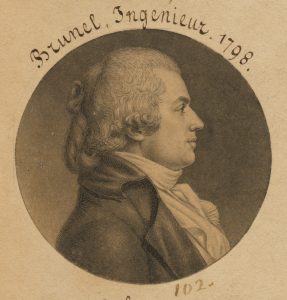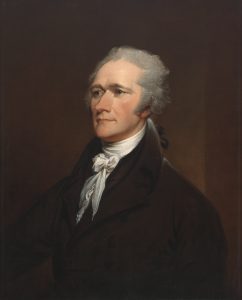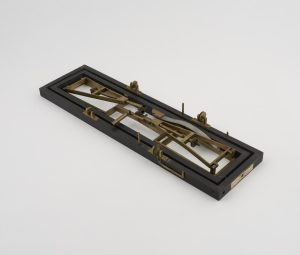Why would Alexander Hamilton, one of the leaders of the American Revolution, want to help Marc Brunel, a Frenchman, get to Great Britain – the former colonial power against whom the Revolution had been fought?
Museum volunteer Mark Kleinman has been researching Marc Brunel’s relationship with Hamilton, and presents some first findings below.
On 7 February 1799, Marc Brunel left the United States of America on the Halifax – a month later he would arrive at Plymouth, where Marc set foot on English soil for the first time.

Portrait of Marc Brunel (1798) by Charles Balthazar Julien Févret de Saint Mémin. National Portrait Gallery, Washington, D.C., S/NPG.74.39.3.13

Portrait of Alexander Hamilton (pre-1806) by John Trumbull, copy after Giuseppe Ceracchi. National Portrait Gallery, Washington, D.C., NPG.79.216.
He had been living in the new nation of the USA for the previous six years, and was now bound for Great Britain, with a head full of ideas and inventions, and a determination to be re-united with the young English woman Sophia Kingdom, and marry her. It is frequently stated that Marc also carried with him a ‘letter of introduction’ from Alexander Hamilton to John George Spencer, the 2nd Earl.
These are two major historical figures. Hamilton, one of the USA’s Founding Fathers, had been the first ever Secretary of the U.S. Treasury serving under the first President, George Washington. Earl Spencer was First Lord of the Admiralty, and hence in command of the Royal Navy. But they are both famous in other ways too! Hamilton is also of course the subject of a musical that has been a huge hit in both London and New York, while Earl Spencer is an ancestor of Princess Diana Spencer, and her sons Prince William and Prince Harry. It is a great story, and one I enjoy telling to visitors in my role as a tour guide at the Brunel Museum.
But, like all great stories, might it be a bit too good to be true? No one, to the best of my knowledge, has been able to produce the famous ‘letter of introduction’. Marc Brunel did go on to work closely with the Royal Navy, and while in the USA he did move in the right circles to bring him into contact with Alexander Hamilton. But what evidence do we have that they actually knew each other? And why would one of the leaders of the American Revolution want to help a Frenchman’s journey to Great Britain, the former colonial power, against whom the Americans had taken up arms only twenty years before?
Helped hugely by Jack Hayes, the Museum’s Collections Access Co-ordinator, I have been digging into this story (please excuse the pun!) and I have found evidence that Alexander Hamilton did indeed know Marc Brunel – although so far at least, there is no sign of a ‘letter of introduction’.
What I have found are two letters one to Alexander Hamilton, and one from him, each mentioning Marc, written in early 1799 – that is, just around the time that Marc sailed for England. On 15 January 1799, Hamilton wrote to Robert Liston, the British Minister (i.e. British Ambassador) in the USA. Unfortunately, this letter has been lost, but Liston’s reply to Hamilton is in the Library of Congress in Washington DC. It reads:
Philadelphia 20 January 1799
Dear Sir,
Mr Brunel delivered to me yesterday your letter of the 15th of this month; and I have furnished him with the passport he wanted for England — I hope I need not add that I shall always be happy that my situation afford me an opportunity of being in any degree useful for those in whom you may take an interest.
I have the honour to be, with perfect truth & regard,
Sir,
Your most obedient servant
Robert Liston
On this letter from Liston, there is a short annotation, in Hamilton’s own hand, that reads ‘who went to England to obtain a Patent for a Copying Machine’. This annotation suggests that Hamilton, some time later, added a note to remind himself who Marc Brunel was.
The second letter that I have found is from Alexander Hamilton to Rufus King, who was at that time the ambassador of the USA in Great Britain. This was written on 6 February 1799, the day before Marc Brunel boarded the Halifax, and reads in part as follows:
Dear Sir
This will be delivered to you by Mr. Isambard Brunell [sic, i.e. Marc Brunel] French by birth, but Anti-Jacobin by principle, and by necessity an Inventor of Ingenious Machines. He goes to England to endeavour to obtain a patent for one, which he has contrived for the purpose of copying. He has a passport from Mr. Liston and I believe our Secretary of State. This letter is to ask for him such patronage as in your situation and in his may be proper […]
Yours truly & Affectionately
A. Hamilton
Here then is evidence not just that Hamilton and Brunel knew each other, but that Alexander Hamilton was actively involved in helping Brunel’s journey from the USA to Great Britain. He wrote to the British Ambassador in the US to secure a British passport for Marc, and to the United States ambassador in London seeking Rufus King’s assistance to Marc when he arrived in England. The political background to this, is that through the 1790s, the USA moved from a pro-France external position to one that was closer to Britain. There were pro-French and pro-British factions within the American political elite, with Hamilton one of the leaders of the pro-British faction. The 1794 Jay Treaty had brought the USA and Britain closer together in trade terms, and by the end of the 1790s, there was an undeclared war – the ‘Quasi-War’ – between the USA and France fought on the high seas.
Marc Brunel was clearly making important contacts in the USA in the 1790s. As well as knowing Alexander Hamilton, when he became an American citizen in 1796, the ‘Witness’ at the district court in New York that granted him citizenship, was , a ‘Judge of the said District’, and a man who had been a member of the House of Representatives and shortly after became a Senator.
So why did Marc choose to leave the USA at this time? Biographies usually refer to two main reasons – first, his wish to be reunited with Sophia, and secondly, to pursue his idea of mechanising the production of ‘ships’ blocks’ for the Royal Navy. But Hamilton’s letter to Rufus King, and Hamilton’s own annotation to Robert Liston’s letter, do not refer at all to ships’ blocks, but rather to Brunel’s need to patent his copying machine in England. And indeed, once in England, Brunel speedily obtained a patent on his ‘machine for writing and drawing’ on 11 April 1799, less than a month after he disembarked at Plymouth. His patents for the ships’ blocks were registered almost two years later.

Model of Marc Brunel’s ‘multiple writing machine’, made to the specifications of the 1799 patent. Science Museum, London, 1891-159/2.
Why did Marc Brunel prioritise his copying machine ahead of the other ideas and inventions in his mind? Was there in fact a ‘letter of introduction’ from Hamilton to Earl Spencer? Or perhaps Rufus King, having been asked by Hamilton to provide Brunel with ‘such patronage as in your situation and in his may be proper’, might himself have arranged an introduction to Earl Spencer?
I shall be continuing to research this fascinating chapter in the life of Marc Brunel, which also sheds light on the history of innovation in both the USA and Great Britain.
For the letters cited above, see also:
The Papers of Alexander Hamilton, vol. 22, July 1798 – March 1799, ed. Harold C. Syrett. New York: Columbia University Press, 1975, pp. 425, 465–466
